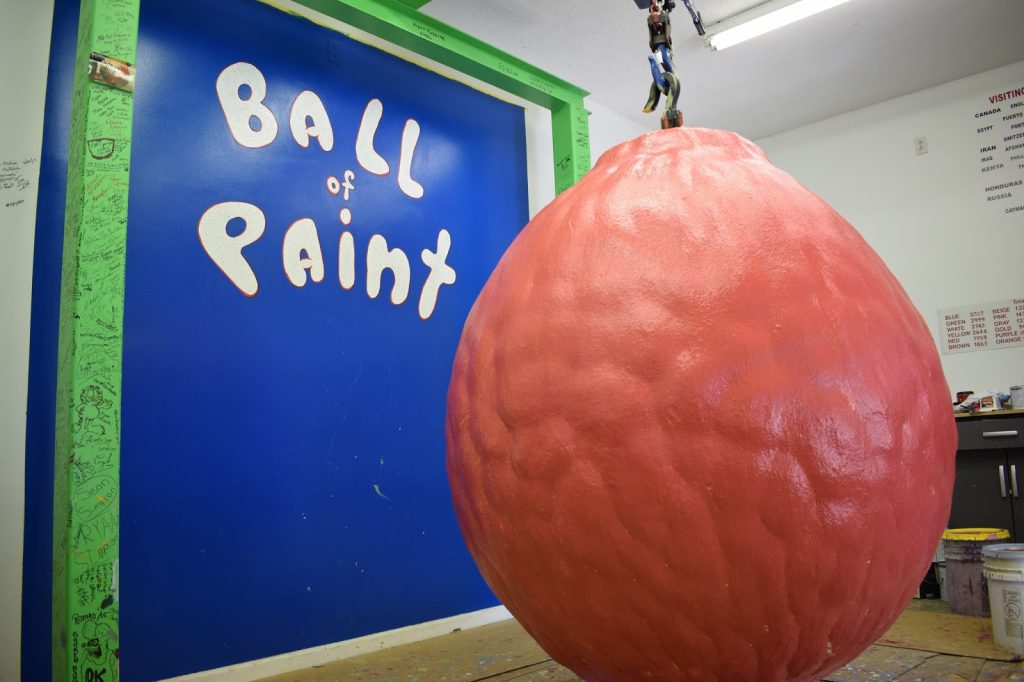Extreme Paint Ball, Literally
The city of Alexandria, Indiana is home to just over 5,000 people. It’s located near the center of the state, about an hour drive north on Interstate 69 from Indianapolis and about a two-hour drive south on the same road from Fort Wayne. (Here’s a map.) The town’s motto is “Small Town USA” according to its Wikipedia entry, suggesting that there’s not a lot to do there — in general, when people are on I-69, they don’t bother stopping off in Alexandria. But if you do, you’ll find a baseball on display.
The ball itself isn’t historically important. It wasn’t signed by Babe Ruth or hit over the fence by Hank Aaron or anything like that. But it’s unlike any baseball you’ve ever seen — or, perhaps, any baseball you can’t see. Because it’s been painted over a few times.
Here’s a picture.
As the wall behind it accurate states, that baseball — it’s under all that orange somewhere, promise! — is the center of the world’s largest ball of paint. As of a few weeks ago, it weighs over 11,000 pounds (about 5,000 kg) — a lot more than a new, unpainted baseball weights (about 5 ounces or 145 grams).
The baseball is the pride and joy of Mike Carmichael, a local guy who really liked how cross-sections of layered paint looked. On October 8, 1964, he started painting a baseball with layer after layer, cutting off sections of the dried, multicolored layers to create neat little art projects for himself. But after applying the 1,000th coat of paint on May 12, 1966, he ended the project. That ball, weighing in at 22 pounds and four ounces (10 kg), still hangs on his ceiling, as seen here. And if you click that link, you’ll see that a thousand-coat painted baseball isn’t a whole lot larger than a typical one — especially compared to the orange behemoth seen above.
The project came back to life on New Year’s Day, 1977. As Roadside American reports, “that day he encouraged his toddler son to cover a baseball with a coat of pastel blue house paint.” And they never stopped. As Mike told Roadside America:
“My intention was to paint maybe a thousand coats on it and then maybe cut it in half and see what it looked like,” Mike said in his soft spoken way, noting that each coat on his ball is a different color from the one before. “But then it got to the size where it looked kinda neat, and all my family said keep on painting it. And I’ve continued on for all these years.”
Over time, the ball has grown — in fact, it outgrew Carmichael’s house, literally. As Atlas Obscura explains, “Eventually, Carmichael was forced to build the ball its very own barn with a specially constructed girder that could support the increasingly heavy paintball. [ . . . ] It has long since lost its spherical shape, taking on a more ovoid form due simply to gravity pulling the paint around as it is applied. Small imperfections have also grown into bulbous lumps, giving the paintball the looks of an alien cocoon.” As of a few weeks ago, the ball had 30,000 layers of paint, each one slightly larger than the one before.
Despite the size of the ball, there’s no end in sight. Carmichael claims that, even today, he or his wife (who has added at least 8,000 coats) paint the ball once or twice a day, unless someone else stops by to grab a paint roller. And that happens more often than you’d think. At some point along the way, news of the world’s largest ball of paint spread, and people from dozens of countries have stopped by the Carmichael’s ball house since. When they do, per Atlas Obscura, “Carmichael allows visitors to add coats when they come to see the thing. They can choose what color they want to add from different buckets of paint, and add their choice to a running tally of top hues (blue is the favorite). Visitors can also walk away with shaved cross-sections of the ball, proof that they contributed to one of America’s newest superlative achievements.”
Carmichael doesn’t charge for the pleasure of adding to his creation, but he does require people to call ahead — he doesn’t want people popping in randomly — and welcomes donations. (Paint isn’t cheap!) If you’re interested, his number is 765-724-4088.
Bonus fact: Ten Downing Street, the official home of the Prime Minister of the United Kingdom, features a black brick façade, as seen here. The bricks have black for as long as anyone can remember, but that’s not by design. As History.com explains, “after the considerable damage sustained by the residence during World War II, complete demolition was considered but ultimately rejected in favor of a massive renovation during the 1950s. The restoration brought with it a surprise—the color of 10 Downing Street’s trademark black façade was thanks to two centuries of London pollution.” When bricks are replaced, officials use yellow bricks, maintaining the history of the building, but then paint them black because tradition dictates it.
From the Archives: Fordite: These look like cool, rainbow rocks. But they’re actually car paint.

